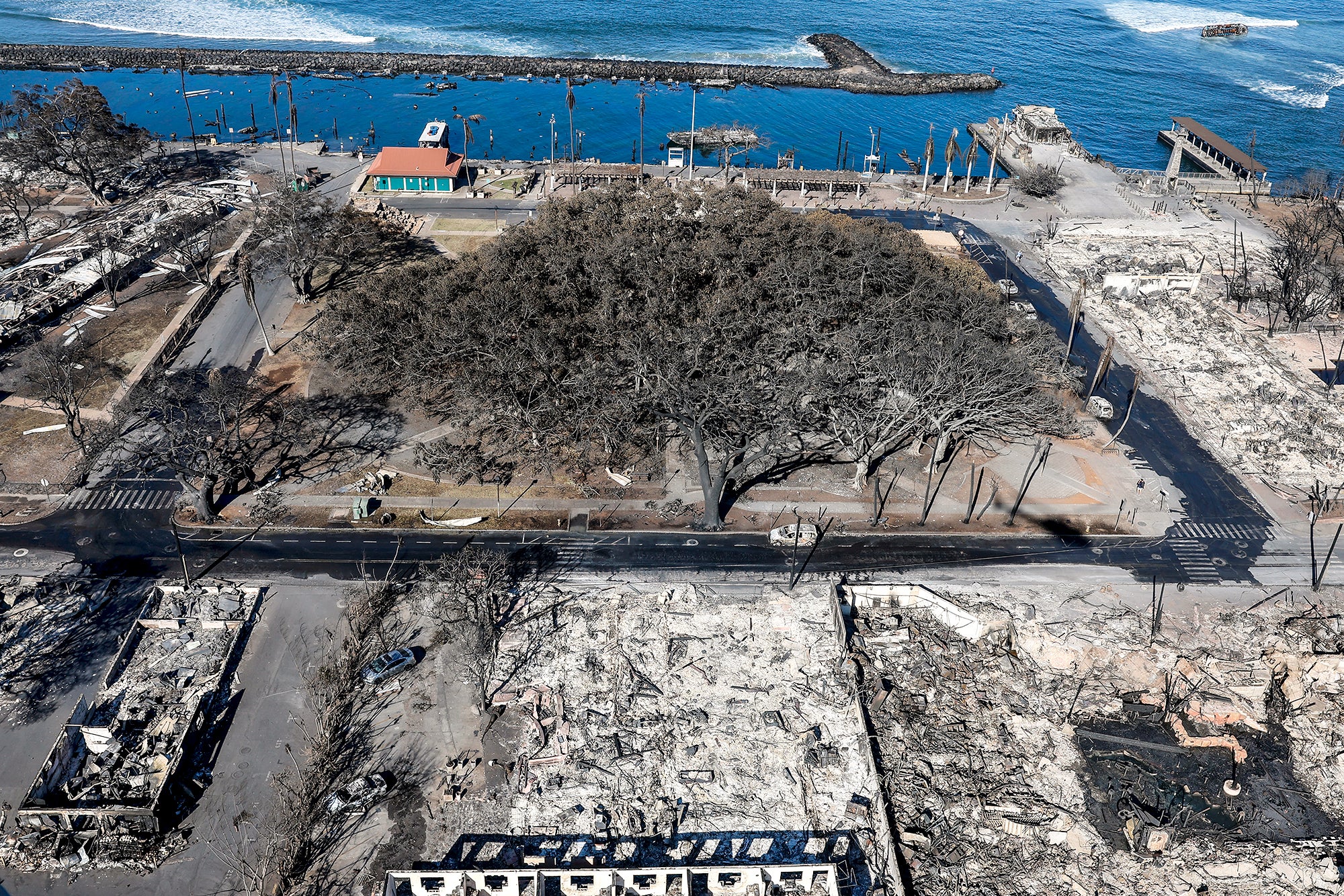
Spanning nearly two acres and multiple centuries, the banyan tree in the heart of Hawaii’s wildfire-ravaged town of Lahaina literally and figuratively looms large. Its sprawling canopy and dozens of trunks offer cooling shade, while its lattice of aerial roots and scarlet-red fruit add character—transforming it, over the years, from an imported Indian sapling into a beloved community hub.
“This is a 150-year-old tree. It just had its birthday party in April. How many trees get a birthday party?” says Winston Welch, executive director of the Outdoor Circle, a conservation organization in Hawaii.
The deadliest wildfire in modern U.S. history ripped through this town on the state’s island of Maui last week. The blaze killed more than 90 people and destroyed most of the community’s homes and infrastructure. Along with the immeasurable loss of human lives, legacies and dreams, Lahaina has also suffered damage to one of its most beloved symbols in the scorched and blackened banyan tree—whose survival remains uncertain.
“As an arborist, it brings tears to my eyes, seeing what I’ve seen in some of the photos,” says Kevin Eckert, founder and president of the nonprofit conservation group Arbor Global in nearby Oahu.
In addition to the banyan tree, Lahaina contains “some of the most historically significant cultural properties and highest-ranking sacred remains of our ancestors,” said Carmen “Hulu” Lindsey, board chair of the Office of Hawaiian Affairs, in a recent press release. Many of these structures lined Lahaina’s Front Street. They included the Pioneer Inn, a hotel dating from the town’s historical days as a whaling port, and the residence of Hawaii’s King Kamehameha III in the 19th century. Before the fires, “on Front street you could start at one end and walk the length and actually move through time—and the evidence of history was still visible,” says Kimberly Flook, an archeologist and deputy executive director of the Lahaina Restoration Foundation.
The blaze utterly destroyed many of these cultural landmarks, but the iconic banyan tree still stands. Its canopy is scorched, its leaves are dead, and its burnt bark and limbs give it an ashy cast. Although the extent of the damage is unknown, residents and local officials are holding on to hope. There is live tissue beneath its bark, yet the tree is like it’s “in a coma,” said Steve Nimz, an arborist who has inspected the banyan, in an interview with Hawaiian television station KITV on Monday.
The tree’s place within the community is unparalleled, Welch says. “It’s such a large and iconic tree, but it’s also a meeting place and shelter. Kids can run under the shade of the tree while the parents sit around and talk. It’s a safe and happy place where undoubtedly romance is made,” he says. “It’s all of those things for Hawaii.”
Hundreds of people usually attend the town’s annual Emma Farden Sharpe Hula Festival, which happens beneath the tree’s canopy and had been planned for last Saturday. Organizers turned this year’s celebration into a virtual benefit.
Eckert says banyan trees are resilient—almost annoyingly so. He has seen some trees ignore root barriers, destroy sidewalks and lift up buildings. “That’s part of the advantage of them and the disadvantage,” he says. “They’re gonna go where they’re gonna go, no matter what you want them to do.”
Protestant missionaries originally imported the tree from India in 1873 at the request of Queen Keōpūolani, a wife of King Kamehameha I, to commemorate the 50th anniversary of the first official Christian mission’s arrival on Maui. Today, by some accounts, this banyan is the largest of its kind in the U.S. and one of the largest in the world. A member of the fig tree family, banyan trees (Ficus benghalensis) are native to the Indian subcontinent. They have found a home in many other tropical locales, however, thanks to features that include their antimicrobial and other medicinal properties.
While banyans have grown across the Hawaiian Islands, their spread has been limited. These trees normally propagate via pollen-carrying wasps—but those wasps haven’t made it to Hawaii. Much of the trees’ cultivation and dispersal there have been achieved by humans, who planted a handful of them throughout the islands.
According to local reports, when Lahaina’s banyan tree was first planted, residents would hang jars of water on its aerial roots to encourage growth. Such roots dangle from a banyan’s long, massive limbs, eventually entering the ground to form a pillarlike new trunk that helps support those limbs. Thus, this eight-foot sapling turned into a veritable forest, with a canopy whose circumference stretches for a quarter mile. This is all the same tree; its spread was stopped only by the buildings around it. A 250-year-old banyan tree near Kolkata, India, measures an even larger 3.5 acres and has weathered two different cyclones and the loss of its main trunk.
Scientists are not sure how resilient banyan trees are to fire. Thin-bark trees, banyans among them, typically fare poorly in wildfires. The heat and flames can readily penetrate their bark and reach the trees’ living cells. Eckert says the lack of readily flammable material surrounding Lahaina’s banyan makes it less likely that fire scorched the tree for a prolonged amount of time. He is reluctant to diagnose the tree without seeing and touching it, however.
“When you see black, that means it is charred, burned; it’s carbonized, and we have a big problem,” he says. “I did not see [char] in the very limited, very few photos. We’re not out of the woods by a long shot, but there is some hope.”
Hope may well be needed. Maui’s mayor Richard Bissen told reporters on Friday that Lahaina was “all gone.” A scorched yet still living banyan would give residents something to rally around. Trucks are already dousing the tree’s roots and soil with water.
“If it were to stand,” Flook says, “it surviving in the heart of the town would certainly be an image as well.”
